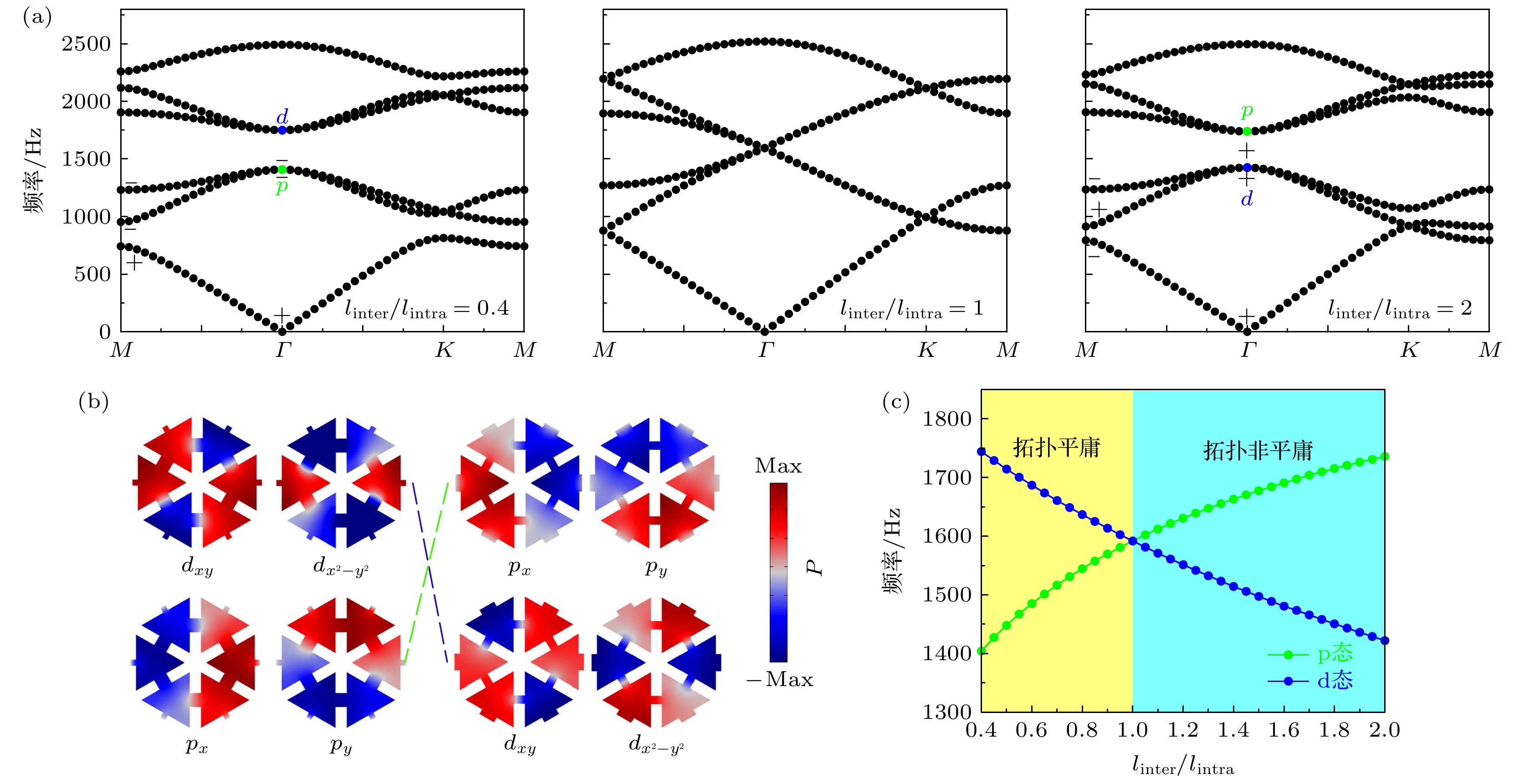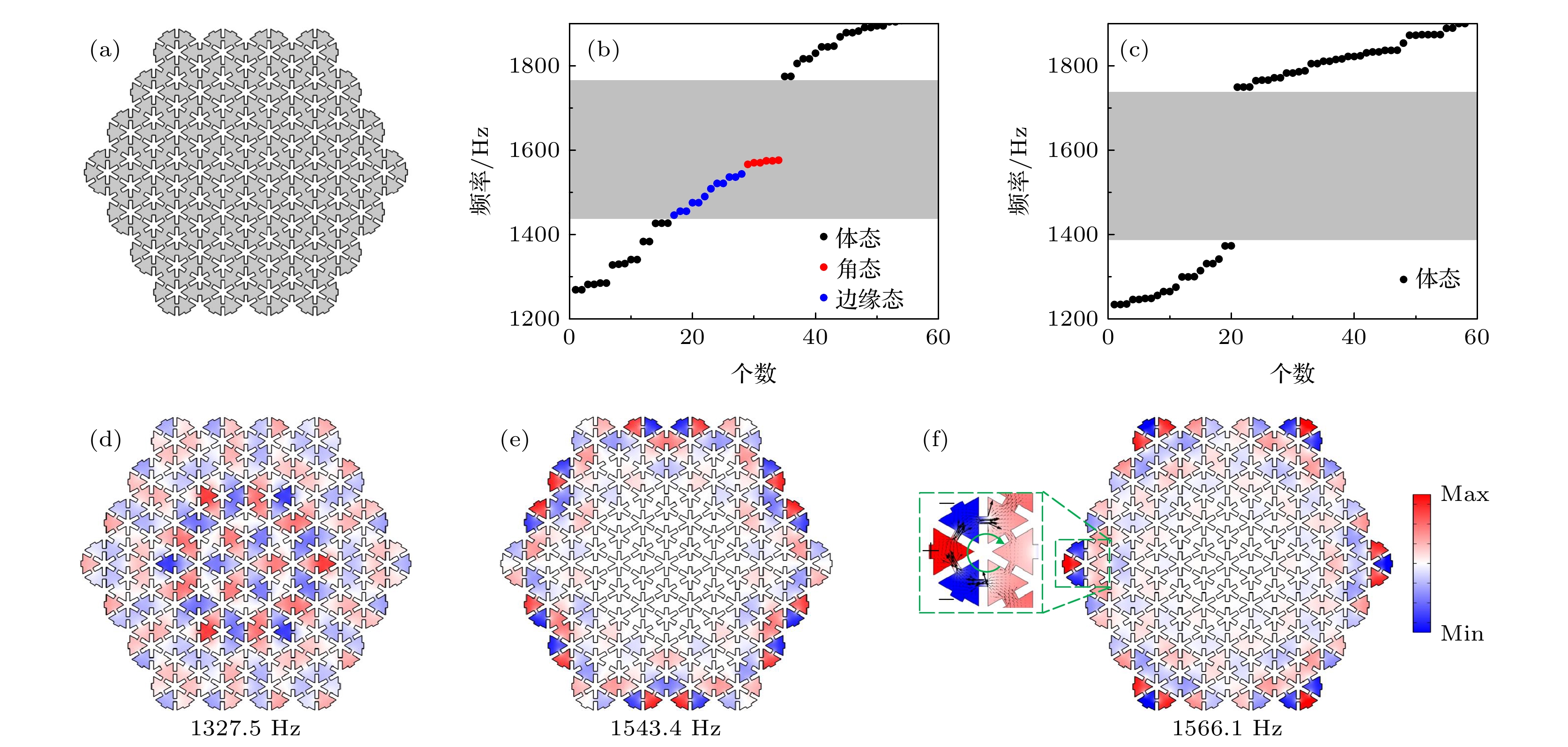-
In recent years, a new type of topological insulator, termed higher-order topological insulator, has attracted tremendous research interest. Such exotic lower-dimensional topological boundary states have been extended and reproduced in classical systems, such as optics and acoustics. In this paper, a two-dimensional acoustic honeycomb structure with a triangle resonant cavity is numerically studied. Topological phase transition is induced by gradually adjusting the intracell and intercell coupling, and then the topological phase is used to construct a second-order topological insulator. The topological properties of second-order topological insulators can be characterized by using the quantized quadrupole moments. When quantized quadrupole
$ {Q_{ij}} = 0 $ , the system is trivial, while$ {Q_{ij}} = 1/2 $ , the system is topologically nontrivial. We investigate the acoustical higher-order states of triangular and hexagonal structures, respectively. The gapped zero-dimensional corner states are observed in both structures, but the robustness properties of the corner states emerge only in the hexagonal structures but not in the triangular-shaped ones. The topological corner modes will offer a new way to robustly confine the sound in a compact acoustic system.[1] Zangeneh-Nejad F, Alu A, Fleury R 2020 CR. Phys. 21 467
[2] Klitzing K v, Dorda G, Pepper M 1980 Phys. Rev. Lett. 45 494
 Google Scholar
Google Scholar
[3] Wang Z, Chong Y D, Joannopoulos J D, Soljacic M 2009 Nature 461 772
 Google Scholar
Google Scholar
[4] He C, Ni X, Ge H, Sun X C, Chen Y B, Lu M H, Liu X P, Chen Y F 2016 Nat. Phys. 12 1124
 Google Scholar
Google Scholar
[5] Lu J, Qiu C, Ke M, Liu Z 2016 Phys. Rev. Lett. 116 093901
 Google Scholar
Google Scholar
[6] 严忠波 2019 68 226101
 Google Scholar
Google Scholar
Yan Z B 2019 Acta Phys. Sin. 68 226101
 Google Scholar
Google Scholar
[7] Bao J, Zou D, Zhang W, He W, Sun H, Zhang X 2019 Phys. Rev. B 100 201406(R
 Google Scholar
Google Scholar
[8] Zheng S, Xia B, Man X, Tong L, Jiao J, Duan G, Yu D 2020 Phys. Rev. B 102 104113
 Google Scholar
Google Scholar
[9] El Hassan A, Kunst F K, Moritz A, Andler G, Bergholtz E J, Bourennane M 2019 Nat. Photon. 13 697
 Google Scholar
Google Scholar
[10] Xie B Y, Su G X, Wang H F, Su H, Shen X P, Zhan P, Lu M H, Wang Z L, Chen Y F 2019 Phys. Rev. Lett. 122 233903
 Google Scholar
Google Scholar
[11] Benalcazar W A, Bernevig B A, Hughes T L 2017 Science 357 61
 Google Scholar
Google Scholar
[12] Mittal S, Orre V V, Zhu G, Gorlach M A, Poddubny A, Hafezi M 2019 Nat. Photon. 13 692
 Google Scholar
Google Scholar
[13] Qi Y, Qiu C, Xiao M, He H, Ke M, Liu Z 2020 Phys. Rev. Lett. 124 206601
 Google Scholar
Google Scholar
[14] Imhof S, Berger C, Bayer F, Brehm J, Molenkamp L W, Kiessling T, Schindler F, Lee C H, Greiter M, Neupert T, Thomale R 2018 Nat. Phys. 14 925
 Google Scholar
Google Scholar
[15] Ezawa M 2018 Phys. Rev. Lett. 120 026801
 Google Scholar
Google Scholar
[16] Xue H, Yang Y, Gao F, Chong Y, Zhang B 2019 Nat. Mater. 18 108
 Google Scholar
Google Scholar
[17] Ni X, Weiner M, Alu A, Khanikaev A B 2019 Nat. Mater. 18 113
 Google Scholar
Google Scholar
[18] Wu J, Huang X, Lu J, Wu Y, Deng W, Li F, Liu Z 2020 Phys. Rev. B 102 104109
 Google Scholar
Google Scholar
[19] Liu F, Wakabayashi K 2017 Phys. Rev. Lett. 118 076803
 Google Scholar
Google Scholar
[20] Zhang Z, Rosendo López M, Cheng Y, Liu X, Christensen J 2019 Phys. Rev. Lett. 122 195501
 Google Scholar
Google Scholar
[21] Chen Z-G, Xu C, Al Jahdali R, Mei J, Wu Y 2019 Phys. Rev. B 100 075120
 Google Scholar
Google Scholar
[22] Fan H, Xia B, Tong L, Zheng S, Yu D 2019 Phys. Rev. Lett. 122 204301
 Google Scholar
Google Scholar
[23] Liu F, Deng H Y, Wakabayashi K 2019 Phys. Rev. Lett. 122 086804
 Google Scholar
Google Scholar
[24] Yang Y, Jia Z, Wu Y, Xiao R-C, Hang Z H, Jiang H, Xie X C 2020 Sci. Bull. 65 531
 Google Scholar
Google Scholar
[25] Zhang Z, Hu B, Liu F, Cheng Y, Liu X, Christensen J 2020 Phys. Rev. B 101 220102(R
 Google Scholar
Google Scholar
[26] Zhang Z, Wei Q, Cheng Y, Zhang T, Wu D, Liu X 2017 Phys. Rev. Lett. 118 084303
 Google Scholar
Google Scholar
[27] Wu L H, Hu X 2015 Phys. Rev. Lett. 114 223901
 Google Scholar
Google Scholar
[28] Liu F, Yamamoto M, Wakabayashi K 2017 J. Phys. Soc. Jpn. 86 123707
 Google Scholar
Google Scholar
[29] Yang Z Z, Li X, Peng Y Y, Zou X Y, Cheng J C 2020 Phys. Rev. Lett. 125 255502
 Google Scholar
Google Scholar
[30] Jiho N, Hassan A, Benalcazar W A, Huang S, Collins M J, Chen K P, Hughes T L 2018 Nat. Photon. 12 408
 Google Scholar
Google Scholar
-
图 1 (a)声学蜂窝结构, 蓝色区域表示单胞; (b)单胞三维结构图; (c)单胞二维结构放大图; (d)单胞对应的第一布里渊区,
${{\boldsymbol{b}}_1}$ 和${{\boldsymbol{b}}_2}$ 为倒格子基矢, 其中${{{{\boldsymbol{b}}}}_1} = {{2{\text{π }}}}/{a}( 0, {{2\sqrt 3 }}/{3} )$ ,${{{{\boldsymbol{b}}}}_2} = {{2{\text{π }}}}/{a}( {1, {{\sqrt 3 }}/{3}} )$ Figure 1. (a) Acoustic honeycomb structure, theunit cell depicted in blue areas; (b) three-dimensional structure diagram of a unit cell; (c) enlarged image of two-dimensional structure a unit cell; (d) the first Brillouin zone (BZ) of the unit cell, where the reciprocal lattice vectors are
${{\boldsymbol{b}}_1} = {{2{\text{π }}}}/{a}( {0, {{2\sqrt 3 }}/{3}} )$ and${{{{\boldsymbol{b}}}}_2} = {{2{\text{π }}}}/{a}( {1, {{\sqrt 3 }}/{3}} )$ .图 2 (a)当
${l_{{\text{inter}}}}/{l_{{\text{intra}}}} = 0.4,$ 1.0, 2.0时, 蜂窝结构的体能带,$ + \left( - \right) $ 号表示偶(奇)宇称; (b)$\varGamma$ 点的本征模式;$ {{\text{p}}_x} $ 和$ {{\text{p}}_y} $ 表示赝自旋偶极模式,${{\text{d}}_{xy}}$ 和${{\text{d}}_{{x^2} - {y^2}}}$ 表示赝自旋四极模式; (c)拓扑相与能带反转; 蜂窝结构具有平庸相($ {l_{{\text{inter}}}}/{l_{{\text{intra}}}} < 1 $ )和拓扑相($ {l_{{\text{inter}}}}/{l_{{\text{intra}}}} > 1 $ ); 从图中也可以清楚地看出能带反转伴随着拓扑相变Figure 2. (a) The bulk band of the honeycomb lattice when
${l_{{\text{inter}}}}/{l_{{\text{intra}}}} = 0.4,$ 1.0, 2.0, ;$ + $ and –, for even and odd parities, respectively; (b) the corresponding acoustic eigenmodesat the$\varGamma$ point;$ {{\text{p}}_x} $ and$ {{\text{p}}_y} $ display pseudospin dipole modes, while${{\text{d}}_{xy}}$ and${{\text{d}}_{{x^2} - {y^2}}}$ mark pseudospinquadrupole modes; (c) topological phase and band inversion;The honeycomb structure has trivial phase ($ {l_{{\text{inter}}}}/{l_{{\text{intra}}}} < 1 $ ) and topological phase ($ {l_{{\text{inter}}}}/{l_{{\text{intra}}}} > 1 $ ); it can also be clearly seen from the figure that the band inversion is accompanied by a topological phase transition.图 3 (a)六边形蜂窝结构; (b)和(c)分别为拓扑和平庸六边形蜂窝结构的本征频谱; 黑色、蓝色和红色的点分别表示体态、边界态和角态. (d)—(f)分别为体态(1327.5 Hz)、边界态(1543.4 Hz)和角态(1566.1 Hz)的本征场分布. 在(f)的插图中给出了角点的顺时针箭头表示赝自旋向下, 符号
$ “\pm ” $ 类似于拓扑荷Figure 3. (a) Hexagonal honeycomb structure; (b) and (c) are the frequency spectrum of the topological and trivial hexagonal honeycomb structure; the black, blue and red dots represent the bulk, edge and corner states, respectively. (d)–(f) The eigen fields distribution of bulk state (1327.5 Hz), edge state (1543.4 Hz) and corner state (1566.1 Hz). The inserted clockwise arrow represents the spin-down pseudospin. The
$ “+(–)” $ signs are similar to the topological charge on the corners.图 5 (a)三角形蜂窝结构; (b)三角形蜂窝结构的本征频谱; (c)角态(1604.5 Hz)的本征场分布; (d)—(f)分别为引入缺陷后的三角形蜂窝结构、本征频谱和角态(1660.2 Hz)的本征场分布
Figure 5. (a) Triangular honeycomb structure; (b) the frequency spectrumof triangular honeycomb structure; (c) the eigenfield distribution of corner state (1604.5 Hz); (d)–(f) triangular honeycomb structure with defects introduced, frequency spectrum and the eigenfield distribution of corner state (1660.2 Hz).
-
[1] Zangeneh-Nejad F, Alu A, Fleury R 2020 CR. Phys. 21 467
[2] Klitzing K v, Dorda G, Pepper M 1980 Phys. Rev. Lett. 45 494
 Google Scholar
Google Scholar
[3] Wang Z, Chong Y D, Joannopoulos J D, Soljacic M 2009 Nature 461 772
 Google Scholar
Google Scholar
[4] He C, Ni X, Ge H, Sun X C, Chen Y B, Lu M H, Liu X P, Chen Y F 2016 Nat. Phys. 12 1124
 Google Scholar
Google Scholar
[5] Lu J, Qiu C, Ke M, Liu Z 2016 Phys. Rev. Lett. 116 093901
 Google Scholar
Google Scholar
[6] 严忠波 2019 68 226101
 Google Scholar
Google Scholar
Yan Z B 2019 Acta Phys. Sin. 68 226101
 Google Scholar
Google Scholar
[7] Bao J, Zou D, Zhang W, He W, Sun H, Zhang X 2019 Phys. Rev. B 100 201406(R
 Google Scholar
Google Scholar
[8] Zheng S, Xia B, Man X, Tong L, Jiao J, Duan G, Yu D 2020 Phys. Rev. B 102 104113
 Google Scholar
Google Scholar
[9] El Hassan A, Kunst F K, Moritz A, Andler G, Bergholtz E J, Bourennane M 2019 Nat. Photon. 13 697
 Google Scholar
Google Scholar
[10] Xie B Y, Su G X, Wang H F, Su H, Shen X P, Zhan P, Lu M H, Wang Z L, Chen Y F 2019 Phys. Rev. Lett. 122 233903
 Google Scholar
Google Scholar
[11] Benalcazar W A, Bernevig B A, Hughes T L 2017 Science 357 61
 Google Scholar
Google Scholar
[12] Mittal S, Orre V V, Zhu G, Gorlach M A, Poddubny A, Hafezi M 2019 Nat. Photon. 13 692
 Google Scholar
Google Scholar
[13] Qi Y, Qiu C, Xiao M, He H, Ke M, Liu Z 2020 Phys. Rev. Lett. 124 206601
 Google Scholar
Google Scholar
[14] Imhof S, Berger C, Bayer F, Brehm J, Molenkamp L W, Kiessling T, Schindler F, Lee C H, Greiter M, Neupert T, Thomale R 2018 Nat. Phys. 14 925
 Google Scholar
Google Scholar
[15] Ezawa M 2018 Phys. Rev. Lett. 120 026801
 Google Scholar
Google Scholar
[16] Xue H, Yang Y, Gao F, Chong Y, Zhang B 2019 Nat. Mater. 18 108
 Google Scholar
Google Scholar
[17] Ni X, Weiner M, Alu A, Khanikaev A B 2019 Nat. Mater. 18 113
 Google Scholar
Google Scholar
[18] Wu J, Huang X, Lu J, Wu Y, Deng W, Li F, Liu Z 2020 Phys. Rev. B 102 104109
 Google Scholar
Google Scholar
[19] Liu F, Wakabayashi K 2017 Phys. Rev. Lett. 118 076803
 Google Scholar
Google Scholar
[20] Zhang Z, Rosendo López M, Cheng Y, Liu X, Christensen J 2019 Phys. Rev. Lett. 122 195501
 Google Scholar
Google Scholar
[21] Chen Z-G, Xu C, Al Jahdali R, Mei J, Wu Y 2019 Phys. Rev. B 100 075120
 Google Scholar
Google Scholar
[22] Fan H, Xia B, Tong L, Zheng S, Yu D 2019 Phys. Rev. Lett. 122 204301
 Google Scholar
Google Scholar
[23] Liu F, Deng H Y, Wakabayashi K 2019 Phys. Rev. Lett. 122 086804
 Google Scholar
Google Scholar
[24] Yang Y, Jia Z, Wu Y, Xiao R-C, Hang Z H, Jiang H, Xie X C 2020 Sci. Bull. 65 531
 Google Scholar
Google Scholar
[25] Zhang Z, Hu B, Liu F, Cheng Y, Liu X, Christensen J 2020 Phys. Rev. B 101 220102(R
 Google Scholar
Google Scholar
[26] Zhang Z, Wei Q, Cheng Y, Zhang T, Wu D, Liu X 2017 Phys. Rev. Lett. 118 084303
 Google Scholar
Google Scholar
[27] Wu L H, Hu X 2015 Phys. Rev. Lett. 114 223901
 Google Scholar
Google Scholar
[28] Liu F, Yamamoto M, Wakabayashi K 2017 J. Phys. Soc. Jpn. 86 123707
 Google Scholar
Google Scholar
[29] Yang Z Z, Li X, Peng Y Y, Zou X Y, Cheng J C 2020 Phys. Rev. Lett. 125 255502
 Google Scholar
Google Scholar
[30] Jiho N, Hassan A, Benalcazar W A, Huang S, Collins M J, Chen K P, Hughes T L 2018 Nat. Photon. 12 408
 Google Scholar
Google Scholar
Catalog
Metrics
- Abstract views: 8292
- PDF Downloads: 408
- Cited By: 0























 DownLoad:
DownLoad:
























